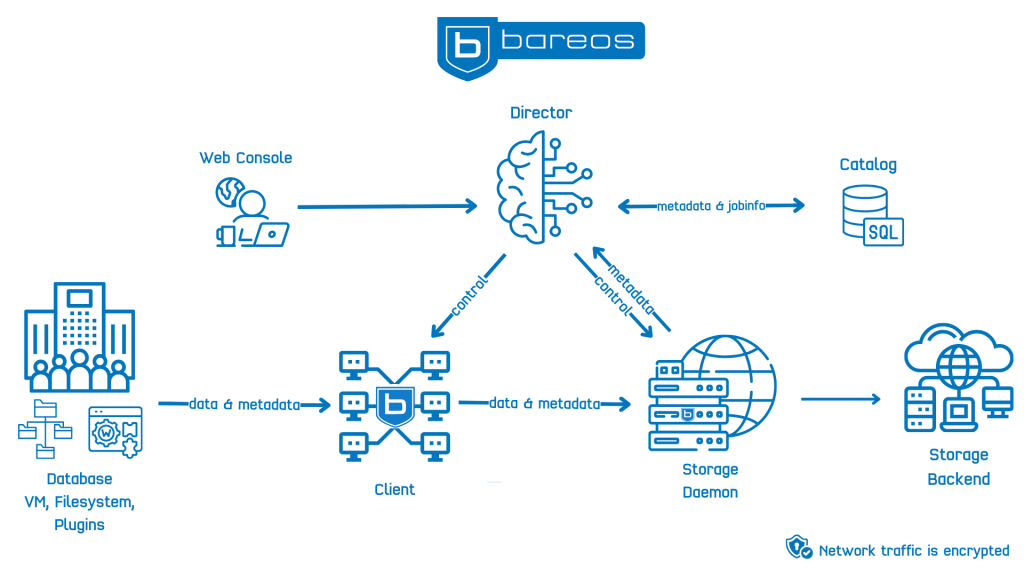A Bareos system consists of several interacting components that allow data to be backed up reliably. In line with the traditional Unix principle, each component performs a specific set of tasks in the backup process. These components communicate over the network.

Key Components of a Bareos System
1. Client (The File Daemon)
One of the main tasks of a backup system is to read the data from the computer requiring backup. During a restore operation, the same data must be returned to the original computer.
In many backup systems, this tool is referred to as an agent or client. In Bareos, this function is performed by the file daemon. This means that the terms client and file daemon are used synonymously.
In this article, we will use the term client when referring to the system being backed up and file daemon when discussing the Bareos tool responsible for the task. Do not let this cause confusion—just remember that the file daemon and client refer to the same function.
2. The Storage Daemon
The data collected by the file daemon must be written to backup media during a backup and read from it during a restore. In a Bareos system, this task is handled by the storage daemon.
The storage daemon is capable of writing backups to hard disks, single-tape drives and automated tape libraries. If a medium changer is used, the storage daemon controls it, automatically inserting the required tape into the drive when needed.
3. The Director Daemon
The director daemon is the central component of the system. It manages all backup, restore and verification tasks.
- It instructs the file daemon to read data and send it to the storage daemon for writing.
- It keeps track of which client has written which files to which storage medium.
- It is responsible for scheduling backups, running them automatically according to defined policies.
- It also manages storage media and collects system messages.
In short, the director daemon is the core of Bareos, controlling all operations.
4. The Catalog
The director daemon relies on a database to store information about completed backups, saved files and used storage media.
This database is referred to as the catalog database, or simply the catalog. Bareos supports PostgreSQL as the database backend for managing catalog data.
The catalog allows Bareos to track backup jobs, file versions and media usage, ensuring data is available for restoration when needed.
5. The Bareos Console
The Bareos console provides a command-line interface for managing the Bareos system. It connects to the director daemon, allowing administrators to perform backup and restore tasks, check system status and configure settings.
The console is a powerful tool for system administrators, providing a direct way to control and monitor backups.
How These Components Work Together
A Bareos system relies on the interaction between these components:
- The Director daemon issues commands to both the file daemon and the storage daemon.
- The Client reads data from clients and sends it to the storage daemon.
- The Storage daemon writes data to the selected backup media.
- The Catalog database stores records of all backup sessions, making it possible to restore data later.
- Administrators use the Bareos console to monitor and manage the entire system.
In its simplest form, a Bareos system consists of:
- One director
- One storage daemon
- One or more file daemons (clients)
Scaling and Flexibility in Bareos
Bareos is not limited to a single-server architecture. Its components can be distributed across multiple locations:
- A single Bareos console can manage multiple directors.
- A single director can control multiple file daemons and storage daemons.
- A file daemon can send backups to multiple storage daemons (but not at the same time).
- A storage daemon can receive data from multiple file daemons simultaneously.
This flexibility allows Bareos to adapt to different environments. For example, in a multi-location setup, one director and storage daemon can be deployed per location.
- Daily backups are written to local storage.
- Full monthly backups are stored at a remote data center for redundancy.
Conclusion
A professional backup system consists of multiple components, each responsible for a specific task. In Bareos, these are:
- Client (File Daemon): Reads data for backup and restores it when needed.
- Storage Daemon: Writes backup data to storage media and retrieves it during restoration.
- Director Daemon: Manages all backup and restore processes.
- Catalog: Stores backup history, file metadata and media usage information.
- Bareos Console: Provides an interface for system administrators to monitor and control backups.
By combining these components, Bareos offers a modular, flexible and scalable backup system suited for various environments, from small businesses to large-scale enterprise deployments.


